The Core Concept
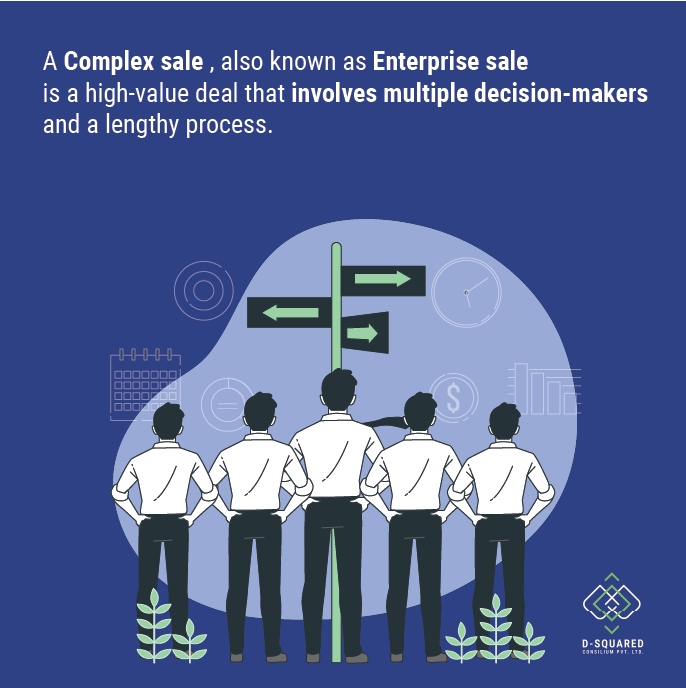
Strategic Selling
Successful Selling in a World of Constant Change
Three Strategic Selling Premises:
1. Past success won’t sustain your future.
2. In Complex Sales, strategy underpins tactical plans.
3. Success in sales requires a deep understanding of your actions and their purpose.
Strategy and Tactics Defined
1. Assess your current standing in relation to the account and your sales goal.
2. Contemplate various alternate positions.
3. Identify the most effective Alternate Position to achieve your objective and create an Action Plan.
4. Put your Action Plan into action.
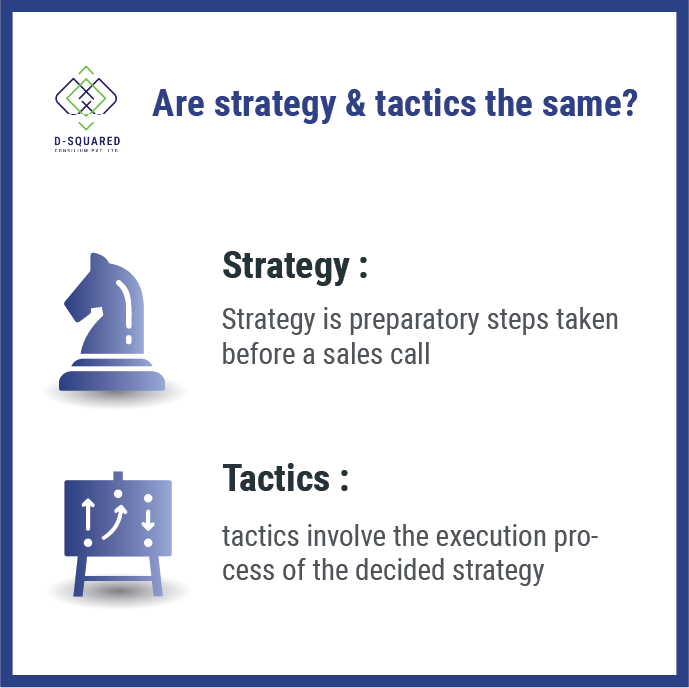
Your Starting Point: Position
In the realm of account strategy, effective positioning is paramount. Thoroughly grasping your current position involves understanding your key players, their sentiments toward you and your proposal, and the array of options they have.
Personal Workshop 1: Position
Step 1: Identify Relevant Changes
List the changes affecting your business approach, categorizing them as sudden events, gradual shifts, or continuous growth.
Step 2: Rate the Changes as Threats or Opportunities
Label changes as opportunities (O) or threats (T) based on your perception of their impact.
Step 3: Define Your Current Single Sales Objective
Clearly articulate your short-term, measurable, and focused sales objective for the chosen account.
Step 4: Test your Current Position
Evaluate your confidence in achieving the objective and make necessary strategy adjustments.
Step 5: Examine Alternate Positions
Explore alternative positions to improve the likelihood of attaining your Single Sales Objective.

Your Strategy Blueprint: The Six Key Elements of Strategic Selling
2. Red Flags/Leverage from Strength
3. Response Modes
4. Win-Results
5. Ideal Customer Profile
6. Sales Funnel
Building on Bedrock: Laying the Foundation of Strategic Analysis
Key Element 1: Buying Influences
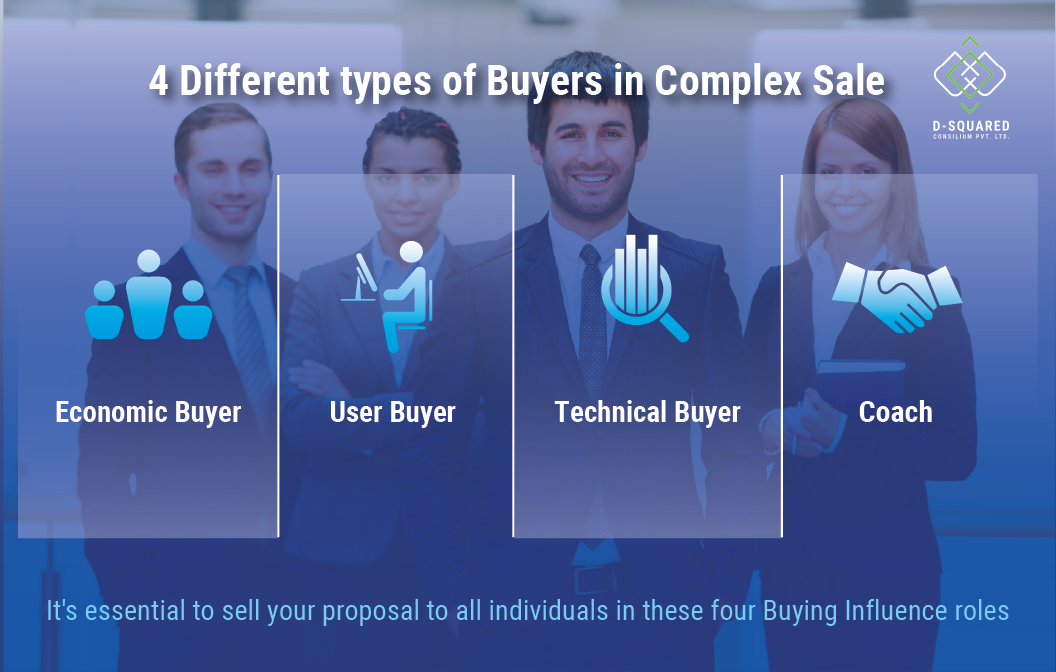
1. Economic Buying Influence: The individual responsible for granting final approval to the purchase.
2. User Buying Influence: Those who evaluate how your product or service will impact their job performance.
3. Technical Buying Influences: Individuals who screen potential suppliers.
4. Coach: The Coach plays a vital role in guiding you towards your sales objective. They provide insights and information to help you effectively engage with the other Buyers.
In Complex Sales, it’s essential to sell your proposal to all individuals in these four Buying Influence roles, rather than assuming that securing approval from a single key decision-maker will ensure success.
Key Element 2: Red Flags/Leverage from Strength
Here are the Five Automatic Red Flag Areas to watch out for:
1. Missing critical information.
2. Uncertainty regarding available information.
3. Any Buying Influence left uncontacted.
4. Buying Influences new to their roles.
5. Organizational reconfigurations.
Buyer Level of Receptivity
It’s crucial to assess the Buyer’s receptivity to your proposals because without this understanding, you might find yourself attempting to sell to someone who isn’t truly engaged.
A Buying Influence can exhibit four distinct reactions, referred to as Response Modes, in a sales scenario. Each mode stems from a unique perception of the immediate business reality, resulting in varying levels of receptivity to incoming sales proposals. As a strategic sales professional, it’s essential to tailor your sales approach to each of these four perceptions.
Key Element 3: The Four Response Modes
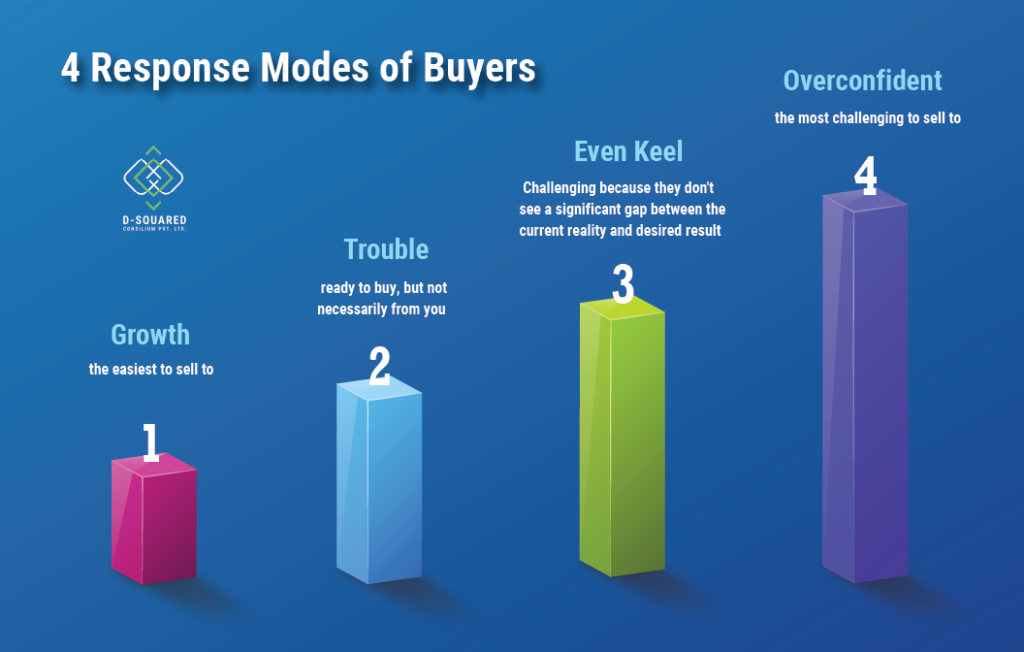
Buyers in the Growth mode are highly likely to take action. They’re acutely aware of the current business situation and the desired outcomes. If a salesperson can bridge the gap between acknowledged reality and desired results, it increases the chances of securing commitment from the Buyer. Trigger words like “more,” “better,” “faster,” and “improved” are often used, signaling receptivity to change. This mode is typically the easiest to sell to.
The Second Response Mode: Trouble
Buyers in Trouble mode also perceive a discrepancy, but it’s different from those in Growth mode. They seek immediate change to reverse or prevent impending defeat. Buyers in Trouble mode are ready to buy, but not necessarily from you. They will approve proposals that swiftly resolve their perceived problems.
The Third Response Mode: Even Keel
Selling to Buyers in Even Keel is challenging because they don’t see a significant gap between the current reality and desired results. Their mindset is “Don’t rock the boat,” and their willingness to take action is low. Making a sale to them becomes more likely if they foresee Growth or Trouble, are influenced by another Buyer in Growth or Trouble, or if you can reveal a discrepancy they hadn’t noticed.
The Fourth Response Mode: Overconfident
Buyers in Overconfident Mode are the most challenging to sell to. The probability of making a sale to them is virtually zero. They perceive reality as surpassing desired results, providing no incentive to change. In this case, the discrepancy works against the selling organization.
The Importance of Winning
In sales encounters, both buyers and sellers hope for a win, but this isn’t always the outcome. The Win-Win Matrix outlines four possible results:
1. I Win-You Win: The Joint Venture Quadrant
– When your Buyers win, you win too, as you gain repeat business and new leads.
– Aligning with your Buying Influences’ self-interests is the most effective way to serve your own.
2. I Win-You Lose: Beating the Buyer
– This quadrant, where you win and the buyer loses, is to be avoided.
– It’s short-term and unstable, inevitably leading to a lose-lose situation over time.
3. I Lose-You Win: Doing the Buyer A “Favor”
– This approach relies on the expectation that the customer will reciprocate in the future.
– The problem is one of perception, as it creates a false sense of reality that is not sustainable.
– Like the Win-Lose quadrant, it eventually degenerates into a lose-lose situation.
4. I Lose-You Lose: The Default Quadrant
– Often referred to as the “catchall” quadrant, it captures sales that haven’t been actively managed into Win-Win outcomes.
– This quadrant represents unintended and unfavorable outcomes, leading to a lose-lose scenario.

Key Element 4: Win-Results
Selling:
Selling is a professional and interactive process aimed at demonstrating to all your Buying Influences how your product or service serves their individual self-interest.
Product:
A product is designed to enhance or address one or more of your customer’s business processes. In Strategic Selling, “product” encompasses both tangible products and services, depending on what you’re selling.
Process:
A process refers to an activity or a series of activities that transform the current state into something different. Examples include shipping, invoicing, production, research and development, and quality control.
Result:
A result is the measurable impact that a product delivers. Results are objective and corporate, focusing on the concrete benefits achieved.
Win:
A Win signifies the realization of a subjective, personal promise made to oneself to advance one’s self-interest in a unique manner. Wins vary from person to person, reflecting individual objectives and aspirations.
Win-Result:
A Win-Result is an objective business outcome that provides one or more of your Buying Influences with a subjective, personal Win, aligning business benefits with individual satisfaction.
Common Problems, Uncommon Solutions
Getting to the Economic Buying Influence: Strategies and Tactics
1. Economic Buying Influences are harder to identify compared to other Buying Influences.
2. They are often more challenging to reach, both physically and psychologically, than those occupying User and Technical Buying roles.
1. What do I need to FIND OUT? – Understand the specific needs and concerns of the Economic Buyer.
2. What do I want the Economic Buyer to KNOW? – Communicate the value and benefits of your product or service clearly
3. What do I want the Economic Buyer to DO? – Encourage them to take actions that align with their business objectives.
4. What do I want the Economic Buyer to FEEL? – Strive to create a positive and confident impression, addressing their emotional aspects.
By addressing these questions, you can improve your approach and communication with Economic Buying Influences, ultimately increasing your chances of a Win-Win outcome.
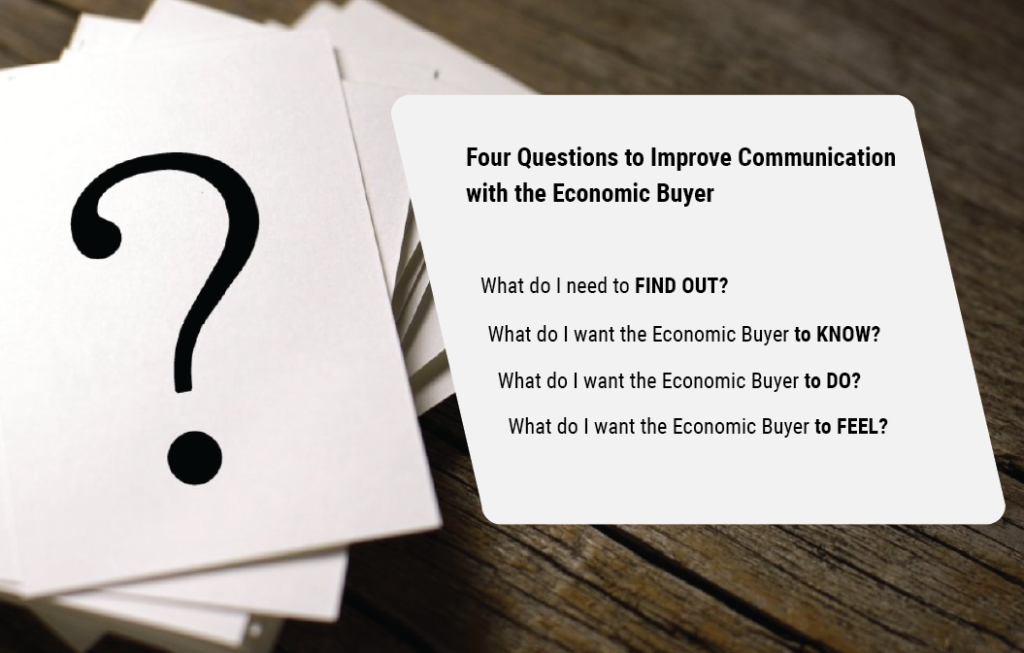
The Coach: Developing Your Prime Information Resource
A proficient Coach primarily functions as an information resource. They not only validate the accuracy of the information you receive but also provide insights that may be otherwise unavailable.
The Three Coaching Criteria:
Your credibility as a salesperson is vital. A Coach will be more effective if they believe in your ability and trust your expertise.
2. The Coach’s Credibility:
The Coach’s own credibility is equally important. Their influence and standing within the organization can significantly impact your sales efforts.
3. Desiring Your Success:
A Coach’s genuine desire for your success is a critical factor. When they are invested in your achievements, they can provide valuable support and guidance to help you achieve your sales goals.
What about the Competition?
In the context of Strategic Selling, competition encompasses any alternative solution to the one you and your company are presenting.
There are several types of competition:
• Buy from someone else.
• Use internal resources.
• Use budget for something else.
• Do nothing

The Proactive Alternative: Restoring Differentiation
Strategy and Territory: Focusing on Your Win-Win Customers
Key Element 5: Ideal Customer
Your Ideal Customer Profile: Demographics and Psychographics
1. Anticipating Problems:
It can help you identify potential issues within your current customer base.
2. Sorting Device:
Acting as a sorting mechanism, it allows you to focus your efforts on the prospects that are most likely to result in a Win-Win outcome, reducing wasted time on less promising leads.
3. Psychographics Matching:
You should aim to align your customers with the psychographics profile of your firm. The better this alignment, the higher the likelihood of achieving Win-Win Results.
Understanding that people don’t buy solely to fulfill objective business needs is crucial. They also make purchases to achieve personal Wins in addition to getting results.
Strategy and Territory: Managing Your Selling Time
Of Time, Territory, and Money
Key Element 6: The Sales Funnel
Four Parts of Refined Funnels
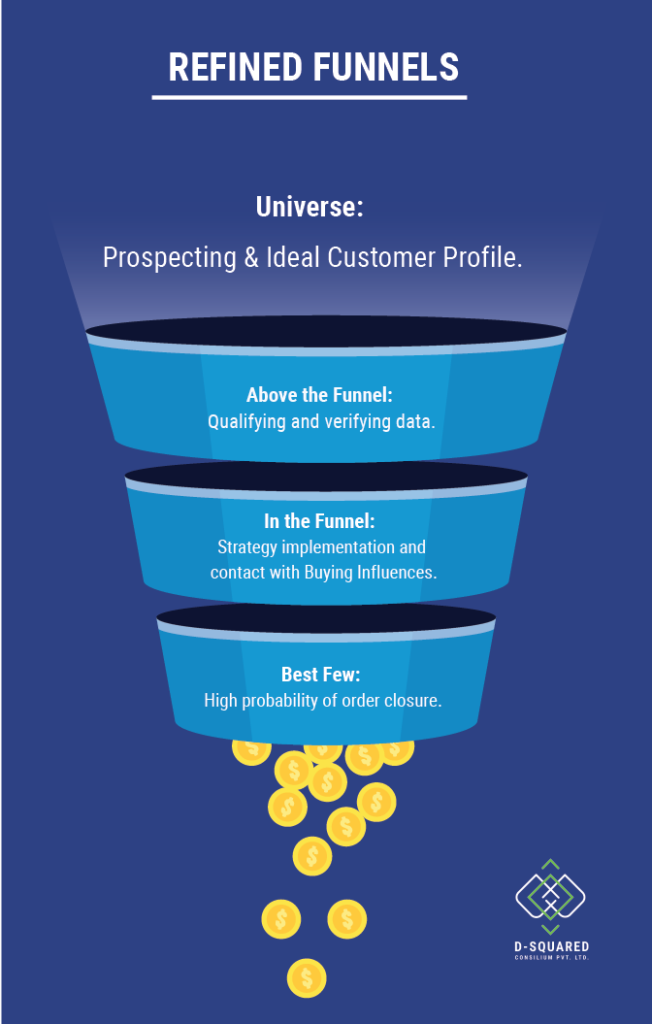
Priorities and Allocation: Working the Funnel
This can be accomplished by:
– Establishing suitable priorities for the four types of selling work that must be undertaken.
– Efficiently allocating your limited selling time to ensure that all four types of work are consistently accomplished.
Roller Coaster Effect: Cause
– When you finish closing all your Best Few and In the Funnel sales objectives, you may find that the top of the Funnel has run dry. This scenario is often referred to as “Dry Funnel Syndrome,” and it contributes to the Roller Coaster Effect in sales.
Roller Coaster Effect: Solution
To counteract the Roller Coaster Effect, arrange your work priorities to prevent dry quarters or dry Funnels.
– Prioritize your tasks in the following sequence:
1. Focus on closing work for your Best Few objectives.
2. Begin prospecting by narrowing down your Universe.
3. Qualify your Above the Funnel objectives.
4. Address the objectives within the Funnel.
By adhering to this priority sequence, you can maintain a steadier and more predictable sales cycle, reducing the impact of the Roller Coaster Effect.
From Analysis to Action
Your Action Plan
Putting the Theory into Action
• Your Single Sales Objective
• The Buying Influences engaged in that objective
• The Response Mode of each Buying Influence
• The Win-Results expected by each Buying Influence
• The level and nature of your competition
Strategy When You Have No Time
1. Identify the accounts and sales objectives that genuinely require a comprehensive “long-form” Action Plan and allocate the time they deserve for thorough planning
2. Embrace a more concise “short-form” action analysis for those sales objectives and upcoming sales calls where circumstances do not permit an extended planning process
Strategy Selling: A Lifetime Approach
There are two pivotal elements in a salesperson’s success:
1. Method: Strategic Selling professionals approach their sales with a systematic set of logical, transparent, and replicable selling steps
2. Constant reassessment: Given the ever-present changes in Complex Sales, your adaptability is crucial. You can only be undermined by change if you fail to adjust to it. To maximize the benefits of Strategic Selling, treat it as a dynamic system that is always in a state of refinement
